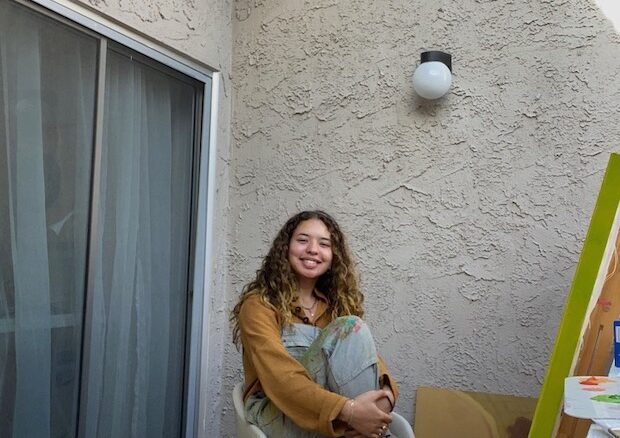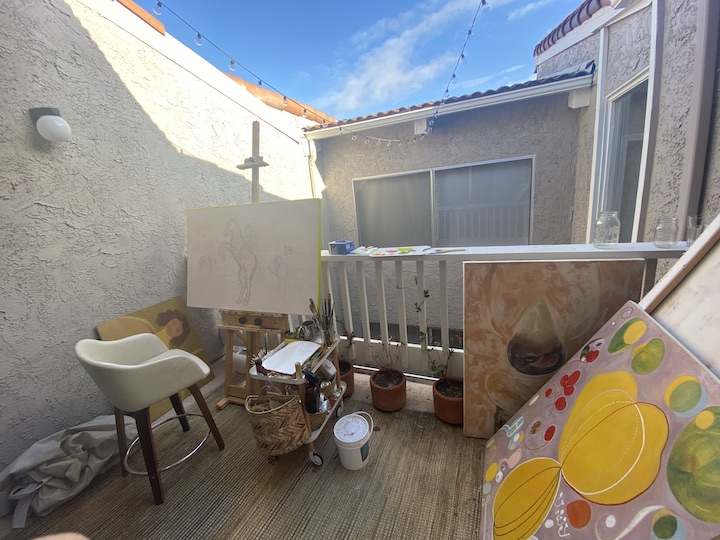
Bedsheets for canvases.
Breakout rooms instead of extensive critiques.
Balconies as fully-functioning art studios.
Pepperdine studio arts students have faced unique challenges amidst the COVID-19 pandemic as they try to navigate hands-on classes through a screen.
In normal years, Pepperdine’s art professors provide a plethora of resources and foster close personal relationships with their students. However, campus restrictions and the formality of Zoom have forced art students and faculty alike to explore their creativity from the confines of their homes.
“Being online interrupts the flow of class,” senior art major Carson Vandermade said. “Usually, we’d just all be working in the same room, and the professor would be able to walk around and instruct us one on one. But now it just interrupts the flow … it’s not as fun.”
Students are facing obstacles with studio space, financial challenges and lack of connection with their peers. However, amidst these difficulties, students and faculty alike have found ways to grow creatively and find the positives in a year of hardship.
Studio space: At home edition
Art students at Pepperdine are accustomed to setting up shop in the large studio spaces that the university provides. This semester, with students spread across the globe, they have carved out their own “studio” wherever they are located.
From cramped apartments to childhood bedrooms, each student has redefined the physical concept of studio space. For junior art major Mya Gordon, this means transforming her outdoor balcony at her Malibu apartment into a painting studio.
“There’s a lot of restriction,” Gordon said. “I can’t explore and be as messy or as free with my painting as I want to be because I’m in a small space that’s outside that I’m renting.”

Gordon also said the rainy season in Malibu further complicates her outdoor space. It is a constant evaluation of where she can safely keep her artwork. Other students are working with even less.
“For my drawing class I would have to clear out a whole area of my room and get all of my drawing stuff out of my closet,” junior art major Spencer Schmidt said. “That led me to procrastinating more … to the point where I would rather work on this for 24 hours straight rather than clear out a space for two hours every day.”

However, not all students saw the change in studio space as a limitation. Vandermade transformed his bedroom into an installation last semester for his junior studio art course.
“I was just in my small one bedroom room that I was making art out of, and I’m broke so I don’t buy a lot of stuff,” Vandermade said. “So I was painting on bedsheets and hanging bedsheets in my room to use my space effectively.”
Vandermade said this crossover between his art and living space blurred the lines between work and play/sleep time. He emphasized that being in an actual studio puts him in a different headspace.
This is why Art Professor Ty Pownall encourages his students to have some sort of consistency in where they create art at home.
“I remind my students and beg my students to set up a studio space that’s a dedicated space in their room for making art,” Pownall said. “Even if it’s three little feet on the ground … something that is home base as their studio.”
Pownall said he recognizes how difficult this is for some students, especially with the residential instability that some are experiencing amidst the pandemic.
An artist’s wallet
In addition to studio space, Pepperdine usually equips students with a multitude of tools such as paints, brushes, canvases, easels, high-tech computers with updated software and more to use on a daily basis for their artwork. Students pay a $60 fee per class.
This year, there is no fee but also no materials available. Students have either had to make do with lower quality materials or empty their pockets to replicate the supplies they typically have access to.
Pownall said he has tried to make his projects as financially accessible as possible, assigning sculpture projects using simple materials such as paper mache, plaster and string. When students get more invested in their craft, however, things can add up quickly.
“Even just taking drawing last semester I spent like $200 just buying pencils and sketchbooks,” Schmidt said. “Things that I know they have mountains of just 10 minutes away from me.”
Schmidt said knowing he would want to buy high quality supplies discouraged him from enrolling in more material-heavy classes this semester, instead opting for digital art courses.
Vandermade’s decision to use bedsheets was partly because they were a cheaper alternative for canvases.
Gordon, on the other hand, learned to stretch her own canvases to lower personal expenses. She said she is fortunate to have accumulated a lot of materials over the years, but she sympathizes with students who are struggling to afford supplies.
Pepperdine has alleviated financial stress on their art students in some ways.
“We’ve been pretty lucky that the university is paying for the Adobe Suite for students,” Digital Arts Professor Kate Parsons said. “So the students don’t have to pay for that out of pocket, which is amazing because it’s expensive.”
The Adobe Suite would usually cost students $20 per month.
Staying connected through a screen
Art classes are different from the traditional class settings in that they are usually informally structured and depend more on personal connections in order to receive meaningful feedback on artwork.
“When it comes to the more creative classes I think a big part of it is being comfortable in a space and getting to know the people,” Schmidt said. “You lose a lot of that over Zoom.”
Schmidt said he thinks the art professors have done a great job at recreating that sense of community. Pownall said he has found this to be the most difficult aspect of online teaching.
“I’m not a very formal person, so the formality of Zoom is hard for me,” Pownall said. “But I’m determined and I try to have discussions even though it’s tough.”
Pownall’s classes usually look like him walking around, talking to students about their art and life in general. Now, he said it’s hard to gauge student engagement through a screen and feels as though he has lost some of the rapport with his students.
The online format also makes it difficult for students to give and receive feedback on their artwork.
“A lot of my work is very tactile,” Gordon said. “I want people to look at it from different ways and walk around it. And it’s also very big and looking at something on a small screen a lot of times isn’t giving the same effect.”
Gordon said she didn’t feel connected to a lot of her peers’ artwork since she couldn’t see it in person. Schmidt echoed this sentiment, and said knowing even a “piece of someone’s existence” makes it easier to care about what they’re making.
Parsons has explored different avenues to build community within her classes.
“I’ve done watch parties a few times, like we’ve done the Netflix party and stuff like that with different shows,” Parsons said. “And people were engaged with it and chatty.”
Parsons said overall, her students have still been really engaged and she is impressed with their level of interaction considering the difficulties of this year.
New avenues
Despite the challenges of online learning, the art community at Pepperdine continues to find the silver linings hidden in this year.
“The thing that’s been really wonderful about this, and I really hesitate to use that word surrounding anything having to do with the pandemic,” Parsons said. “But we’ve been able to bring in lecturers from all over the world, and that is just not something we’d be able to do otherwise.”
Parsons said she hopes to continue bringing in guest speakers even after in-person classes resume. Parsons also said that although she very much misses the virtual reality component of her digital arts classes, she has been able to incorporate more aspects of augmented reality, which could not be done on Pepperdine’s campus due to privacy concerns.
Augmented reality requires individuals to log in using their social media accounts, which the university did not want students doing on university computers. Now, students can use their own devices.
Some students are seeing this past year as a sneak peek into what their life as a working artist might look like.
“I think it has put a lot of responsibility in my hands,” Vandermade said. “In reality, once we graduate it’s going to be up to us whether we want to maintain the studio practice.”
Gordon also said having to make her own studio space and time outside of class to work on art has felt like a crash course for life outside of school.
The lessons from this year will not be forgotten when in-person classes resume. Parsons said she thinks students and faculty are better at giving each other grace after this year. Pownall said he has been especially thankful for his students amidst the pandemic.
“It’s one of the reasons I love working with college students,” Pownall said. “You have a lot of energy, you’re resilient, you have a lot of creativity, you’re generally very optimistic people … that’s been really healthy for me to have in my life right now.”
Megan Rose completed the reporting for this story in Jour 241 in Fall 2021 under the supervision of Dr. Christina Littlefield and Dr. Theresa de los Santos. Dr. Littlefield supervised the web version of the story.




